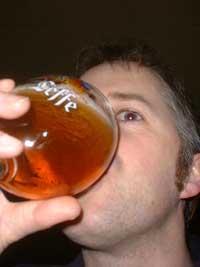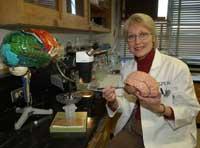The way of alcohol on a body
2002/09/29 Carton Virto, Eider - Elhuyar Zientzia
It is called ethanol and is an essential component of alcoholic beverages. To it alcoholic drinks owe an intense taste and to it we humans owe drunk. In fact, ethanol is a small molecule that easily spreads throughout the body as soon as it passes into the blood. How much, how and who takes it, the effect will be greater or less, but little leaves the alcohol tempered.

Alcohol comes through the mouth to the stomach and from the stomach to the intestine in a few minutes. Most pass into the blood in the small intestine. In case of fasting, the amount of alcohol in blood reaches its maximum in 45 minutes and in an hour and a half if taken with food. Food causes the stomach to empty more slowly and alcohol costs more to reach the blood. However, you also need to consider what you eat, as sugars, for example, accelerate absorption. And even if it seems a lie, alcoholic beverages have an opposite effect. These drinks contract the muscles of the walkway between the stomach and intestine, so they pass through it unless wine or beer.
Once in the blood, ethanol rapidly expands to all organs in the body. Alcohol is water-soluble and accumulates in organs, tissues and muscles, where there is water, but not fat. For this reason, despite taking the same dose, women have a higher degree of alcohol than men, as they generally have more fat in proportion.
Alcohol especially affects the organs that receive the greatest blood flows, in the case of humans the brain, liver and lungs. Sweating, urine and, in the case of breastfeeding women, the expulsion of ethanol is done slightly through milk, but especially thanks to the work of the liver the destruction of it. Although energy is produced in this process, alcohol is not thought to be a good source of energy. Alcohol causes dilation of the superficial veins and cooling of the body due to increased heat exchange between the skin and the environment.
Alcohol is removed much more slowly than alcohol; the body removes 0.15 grams of alcohol per hour and per liter of blood.
Drunk of three phases

Drunkenness is mainly due to alcohol that reaches the brain. Three phases are known. It produces euphoria while alcohol in blood is less than 0.7 grams per liter. Inhibitions are overcome and restlessness is manifested, altering attention, perception, memory and balance. From there, up to 2 grams per liter, we pass from euphoria to drunk. Balance problems, mental disorders, and sometimes aggressiveness and hallucinations may occur. At these levels alcohol stops being stimulant and decreases considerably. If more is taken, an ethyl coma may occur.
Drunkenness is an underestimation of the dangers, but it usually goes well asleep. From the public health point of view, the excessive and chronic consumption of alcohol is one of the biggest problems and, in view of the limitation set by the World Health Organization, the threshold of damage is less than imaginable: 2-3 units of alcohol daily for women and 3-4 for men. One unit is 10 g ethanol approximately 100 cl wine or 25 cl beer
Of course, the liver is the main objective of alcohol, since it metabolizes most of the alcohol. And the typical disease, cirrhosis. In the livers affected by cirrhosis there is a fibrous tissue that as it develops can produce hepatitis, bleeding and cancer. However, as seen in the scheme, the field of action of alcohol occupies the whole body. And as if all this were not enough, it has been proven that alcoholic people can suffer serious nutritional deficiencies and that hence motor and psychic problems can be derived.
Mechanism of action of alcohol
Numerous studies have been conducted on alcohol toxicity. It has been proven that globally alcohol acts on the cell membrane. The cell membrane plays a fundamental role, as it is responsible for controlling everything that enters and leaves the cell, and is very sensitive to changes.

As for the brain, ethanol generates many responses and counterbets. It is stimulating, but it also weakens, causes euphoria, but also anxiety. This is because ethanol alters various systems of brain action. In people who are not alcoholic, drinking too much skinny alcohol. In the case of chronic drinkers, the brain seems to get used to it, so when they do not drink alcohol there is an excess of nervousness. As for humor, the same thing. Ethanol causes a greater release of serotonin in the brain, a molecule with antidepressant functions, but in the case of chronic drinkers it causes depression.
Dependence appears to be associated with increased dopamine production. And this time it follows the complicated path. Ethanol acts on the control points of compounds equivalent to the active morphine and cannabis molecule, which causes the release of dopamine. Dopamine is a neurotransmitter related to pleasure, hence dependence.
It is clear, therefore, that alcohol is a drug and not an ordinary drug. Moreover, being a broader framework of action than the rest, it is more difficult to escape from its clutches.
Alcohol damage
- Brain. Cognitive and psychological problems, depression; epilepsy; vascular accidents...
- Eyes. Neuritis of the optic nerve.
- Esophagus. Irritation and inflammation; reflux; ulcers and varicose veins; cancer.
- Circulatory apparatus. Hypertension, anemia, hematologic problems.
- Heart. Heart rhythm disturbances; cardiomyopathy and cardiac accidents.
- Stomach. Vomiting and vomiting; acute or chronic alcoholic gastritis; bleeding.
- Intestines. Bleeding damage; diarrhea. Rectal cancer.
- Legs. Polineuro (cramps or sensory disturbances that may end in paralysis)
- Sexual apparatus. Atrophy in the ovaries or testicles; sexual dysfunctions.
- Area. Acute or chronic pancretitis; diabetes.
- Liver. Steatosis (fat degeneration); hepatitis; alcoholic cirrhosis; cancer.
- Respiratory system. Excess salivation; dental diseases; cancer of the mouth, larynx, and pharynx.
Published in 7K.

Gai honi buruzko eduki gehiago
Elhuyarrek garatutako teknologia






